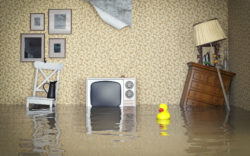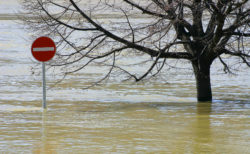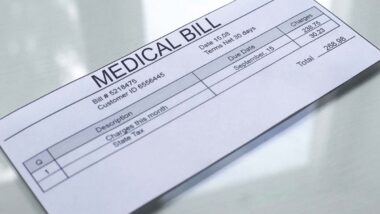Top Class Actions’s website and social media posts use affiliate links. If you make a purchase using such links, we may receive a commission, but it will not result in any additional charges to you. Please review our Affiliate Link Disclosure for more information.

Ask many homeowners who live in California, Texas, Florida or North Carolina if they would have thought they needed flood insurance five years ago, and they might have rolled their eyes, laughed, and said, “Never!” Yet many of these people are now paying tens of thousands of dollars out of their own pockets to repair flood damage they never thought they’d experience.
Generally, any homeowner paying a mortgage on a property in a government-deemed flood zone is required to carry flood insurance on the home. If the home is damaged due to flooding, these homeowners at least have the peace of mind of knowing the damage will be covered.
FEMA says the average annual premium for flood insurance is just under $700, but can range from $150 a year for a low-risk property to around $1,400 a year for a high-risk property.
Securing Flood Insurance
FEMA’s National Flood Insurance Program (NFIP) was created in the 1960s after insurance companies complained they could go broke if they had to insure every home against flooding under a normal homeowners insurance policy.
The government-issued flood insurance covers a maximum of $250,000 for a home and $100,000 for the home’s furnishings and other contents.
If you own a home worth more than $250,000, you can find an insurance company that offers private policies of flood insurance that are not funded through NFIP. That way, you can obtain a higher amount of coverage. In some cases, the state will back the flood insurance policy by a guaranty fund, which means you will still have flood insurance even if the insurance company goes out of business.
A private flood insurance policy might carry a higher premium, but the private insurance company will most likely offer you a more accurate flood risk assessment.
There are a couple of risks of private flood insurance. The bank that carries your mortgage might reject a private flood insurance policy because banks prefer NFIP policies that are backed by the federal government. If you live in a high-risk area, the private insurance company might refuse to provide your home coverage simply because the chances the company will have to make a big payout to you are too great.
Is Your Home in a High-Risk Flood Zone?
According to FEMA, more than 20 percent of flood claims are received from people who own properties that fall outside high-risk flood zones.
The FEMA Flood Map Service Center provides a website that indicates the level of flood risk your home has been given. These flood maps are used to determine flood insurance ratings, determine areas where flood insurance is required, and for floodplain management in general.
Flood hazards and geographical makeup change over the course of time. When new developments are added to communities, the entire direction of water flow during rain may be impacted and place new areas at flood risk. The development of a new nearby mine, for example, can change the way water flows down through a community.
Even changing weather patterns, wildfires or other dramatic changes in terrain can affect the potential that your home could be flooded.
After severe wildfires, badly burned and dead vegetation for acres on end destroy the water flow patterns that had existed for years. When a fire burns especially long and hot, the soil virtually bakes and becomes rock hard. According to the California Natural Resources Agency, burnt plants release their cellulose in a gaseous form that settles on top of the soil and acts as a natural sealant, further inhibiting the soil’s ability to absorb water. California has lost more than 147 million trees since the state’s drought began in 2010.
Flood Map Updates
Because of intense and expensive damages that many homes and businesses unexpectedly have faced over the last several years, FEMA is working with communities to update the flood risk maps.
As the maps are updated, your property could be impacted by these changes. For instance, if your home previously fell in a moderate- to low-risk flood area and is now deemed in the high-risk flood range, you will be required by law to obtain flood insurance if you have a federally insured mortgage on the property. Your insurance agent should be able to help you find the lowest premium to insure your home, and the policy must be in effect within 12 months of the new map’s effective date.
Even if you are fortunate enough to have your property deemed less of a flood risk under the new mapping, flood insurance is still highly recommended. According to FEMA, lower-cost Preferred Risk Policies start at under $325 per year. You have good reason to consider keeping your flood insurance if you were originally in a higher risk area for flooding. Even if your area is no longer high-risk, remember that 20 percent of all flood claims originate from moderate- and low-risk lands.
If your home was already in a high-risk flood plain that has increased in vulnerability and is now in a higher-risk flood plain, you should purchase and maintain coverage before FEMA finalizes the map. That way, you will be able to lock in your current lower-risk zone for future ratings.
If the flood risk stayed the same with the new map’s designations, it’s best to speak with your insurance agent to make sure your home and its contents are adequately insured. Most regular homeowners insurance policies won’t cover flood damage, and it will need to be purchased additionally.
If You Need Flood Insurance, Know What it Covers
Even if you have had a flood insurance policy for years, you should review your policy every few years because under the old terms, you might find yourself underinsured in the event of a catastrophe. If you have made changes to your property that aren’t reflected in your flood insurance policy, you can talk to your insurance agent to make sure the improvements are covered by the flood insurance policy.
Like other types of homeowners insurance, a basic flood insurance homeowners policy will usually only pay you the depreciated dollar amount for your personal property — like older stereo systems, couches, bookcases, etc. To ensure you will receive enough money to cover the actual replacement of everything, it’s best to ask for a policy that will pay you 125 percent of the insured value.
Things that the NFIP flood insurance usually won’t cover include basements, mold or mildew that was cause caused by the flooding that the homeowner could have prevented, septic systems, pools, decks, motor vehicles, trees, plants or fences. Collections of precious metals and any stock certificates/bonds/cash are not generally covered by NFIP. Plus, any temporary housing needs are most often the responsibility of the homeowner and are not insurable expenses through NFIP.
Another financial implication to keep in mind is that whenever a natural disaster impacts entire communities, the cost of drywall, cement and other construction materials usually skyrockets due to the excessive demands.
Flooding Ranges from One Inch to Several Feet of Water
According to FEMA, 90 percent of the natural disasters in the U.S. include some type of flooding. Most people immediately associate flooding with hurricane conditions, but homes and businesses suffer catastrophic damage from inland flooding, flash floods, melting snow from nearby mountains and seasonal rains.
FEMA says one inch of water in a home can cause more than $27,000 damage. Flash floods often carry water and debris 10 to 20 feet high.
With more than 3 million miles of rivers and streams, many Americans have beautiful views that can turn into nightmare flooding situations. The U.S. also has 95,000 miles of shoreline, ripe for flooding at various times of the year.
The federal government produced the 2014 Climate Assessment that said, “Warmer air can contain more water vapor than cooler air. Global analyses show that the amount of water vapor in the atmosphere has in fact increased due to human-caused warming. This extra moisture is available to storm systems, resulting in heavier rainfalls.”
Scientists also believe that warmer air causes the storms to become more powerful.
Saving Money on Flood Insurance Premiums
Your insurance agent should be able to present options for either NFIP flood insurance or private flood insurance. In some cases, you might opt for both NFIP and private insurance if your home is worth more than $250,000 and the contents are worth more than $100,000. Compare quotes provided by your insurance agent.
As with other kinds of insurance, you can save money if you increase your deductible. As a homeowner, though, you must realize you will have two deductibles in the event of a flood: one deductible for the structure and one deductible for everything in that structure.
As FEMA continues to update the flood maps, it’s best to keep your current policy up-to-date and not allow it to expire. For one reason, it can take 30 days before a flood insurance policy becomes effective. Secondly, if your home originally fell in a lower risk category, the property might be grandfathered in at that lower flood insurance rate, which means your premiums will be lower than if you start all over again.
In addition, if you are buying a home and the current homeowner has flood insurance, see if that policy can be transferred to you. The current homeowner might have a lower rate than you would be able to secure if the home has been re-mapped and now falls into a higher risk flood category.
Renters can also benefit from flood insurance, but it is less expensive because they only need the personal property component of the policy for a maximum of $100,000 coverage. If you buy less than $100,000 coverage or opt for a higher deductible, your premium will go down. Keep in mind that a regular renters insurance policy does not cover flood damage.
Join a Free Disaster Insurance Claim Investigation
It is important that you make sure you are properly compensated by your insurance company for the damage caused by a hurricane, flood, or fire. Get help today from experienced insurance claim attorneys.
ATTORNEY ADVERTISING
Top Class Actions is a Proud Member of the American Bar Association
LEGAL INFORMATION IS NOT LEGAL ADVICE
Top Class Actions Legal Statement
©2008 – 2024 Top Class Actions® LLC
Various Trademarks held by their respective owners
This website is not intended for viewing or usage by European Union citizens.
Get Help – It’s Free
Join a Free Disaster Insurance Claim Investigation
If you qualify, an attorney will contact you to discuss the details of your potential case at no charge to you.
PLEASE NOTE: If you want to participate in this investigation, it is imperative that you reply to the law firm if they call or email you. Failing to do so may result in you not getting signed up as a client or getting you dropped as a client.
E-mail any problems with this form to:
Questions@TopClassActions.com.
Oops! We could not locate your form.













